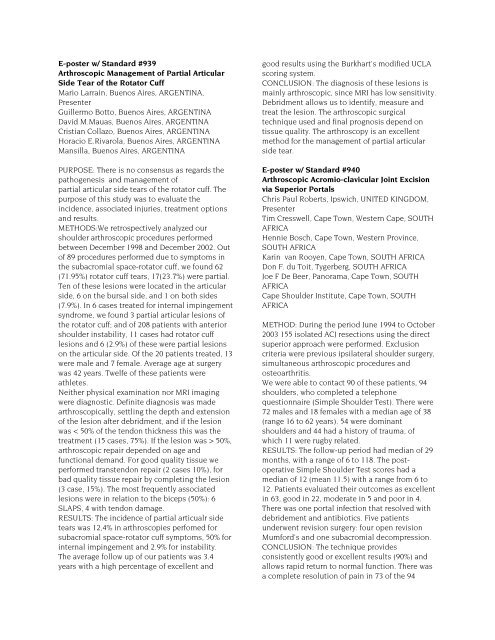POSTER ABSTRACTS - ISAKOS
POSTER ABSTRACTS - ISAKOS
POSTER ABSTRACTS - ISAKOS
Create successful ePaper yourself
Turn your PDF publications into a flip-book with our unique Google optimized e-Paper software.
E-poster w/ Standard #939<br />
Arthroscopic Management of Partial Articular<br />
Side Tear of the Rotator Cuff<br />
Mario Larrain, Buenos Aires, ARGENTINA,<br />
Presenter<br />
Guillermo Botto, Buenos Aires, ARGENTINA<br />
David M.Mauas, Buenos Aires, ARGENTINA<br />
Cristian Collazo, Buenos Aires, ARGENTINA<br />
Horacio E.Rivarola, Buenos Aires, ARGENTINA<br />
Mansilla, Buenos Aires, ARGENTINA<br />
PURPOSE: There is no consensus as regards the<br />
pathogenesis and management of<br />
partial articular side tears of the rotator cuff. The<br />
purpose of this study was to evaluate the<br />
incidence, associated injuries, treatment options<br />
and results.<br />
METHODS:We retrospectively analyzed our<br />
shoulder arthroscopic procedures performed<br />
between December 1998 and December 2002. Out<br />
of 89 procedures performed due to symptoms in<br />
the subacromial space-rotator cuff, we found 62<br />
(71.95%) rotator cuff tears, 17(23.7%) were partial.<br />
Ten of these lesions were located in the articular<br />
side, 6 on the bursal side, and 1 on both sides<br />
(7.9%). In 6 cases treated for internal impingement<br />
syndrome, we found 3 partial articular lesions of<br />
the rotator cuff; and of 208 patients with anterior<br />
shoulder instability, 11 cases had rotator cuff<br />
lesions and 6 (2.9%) of these were partial lesions<br />
on the articular side. Of the 20 patients treated, 13<br />
were male and 7 female. Average age at surgery<br />
was 42 years. Twelfe of these patients were<br />
athletes.<br />
Neither physical examination nor MRI imaging<br />
were diagnostic. Definite diagnosis was made<br />
arthroscopically, settling the depth and extension<br />
of the lesion after debridment, and if the lesion<br />
was < 50% of the tendon thickness this was the<br />
treatment (15 cases, 75%). If the lesion was > 50%,<br />
arthroscopic repair depended on age and<br />
functional demand. For good quality tissue we<br />
performed transtendon repair (2 cases 10%), for<br />
bad quality tissue repair by completing the lesion<br />
(3 case, 15%). The most frequently associated<br />
lesions were in relation to the biceps (50%): 6<br />
SLAPS, 4 with tendon damage.<br />
RESULTS: The incidence of partial articualr side<br />
tears was 12,4% in arthroscopies perfomed for<br />
subacromial space-rotator cuff symptoms, 50% for<br />
internal impingement and 2.9% for instability.<br />
The average follow up of our patients was 3.4<br />
years with a high percentage of excellent and<br />
good results using the Burkhart’s modified UCLA<br />
scoring system.<br />
CONCLUSION: The diagnosis of these lesions is<br />
mainly arthroscopic, since MRI has low sensitivity.<br />
Debridment allows us to identify, measure and<br />
treat the lesion. The arthroscopic surgical<br />
technique used and final prognosis depend on<br />
tissue quality. The arthroscopy is an excellent<br />
method for the management of partial articular<br />
side tear.<br />
E-poster w/ Standard #940<br />
Arthroscopic Acromio-clavicular Joint Excision<br />
via Superior Portals<br />
Chris Paul Roberts, Ipswich, UNITED KINGDOM,<br />
Presenter<br />
Tim Cresswell, Cape Town, Western Cape, SOUTH<br />
AFRICA<br />
Hennie Bosch, Cape Town, Western Province,<br />
SOUTH AFRICA<br />
Karin van Rooyen, Cape Town, SOUTH AFRICA<br />
Don F. du Toit, Tygerberg, SOUTH AFRICA<br />
Joe F De Beer, Panorama, Cape Town, SOUTH<br />
AFRICA<br />
Cape Shoulder Institute, Cape Town, SOUTH<br />
AFRICA<br />
METHOD: During the period June 1994 to October<br />
2003 155 isolated ACJ resections using the direct<br />
superior approach were performed. Exclusion<br />
criteria were previous ipsilateral shoulder surgery,<br />
simultaneous arthroscopic procedures and<br />
osteoarthritis.<br />
We were able to contact 90 of these patients, 94<br />
shoulders, who completed a telephone<br />
questionnaire (Simple Shoulder Test). There were<br />
72 males and 18 females with a median age of 38<br />
(range 16 to 62 years). 54 were dominant<br />
shoulders and 44 had a history of trauma, of<br />
which 11 were rugby related.<br />
RESULTS: The follow-up period had median of 29<br />
months, with a range of 6 to 118. The postoperative<br />
Simple Shoulder Test scores had a<br />
median of 12 (mean 11.5) with a range from 6 to<br />
12. Patients evaluated their outcomes as excellent<br />
in 63, good in 22, moderate in 5 and poor in 4.<br />
There was one portal infection that resolved with<br />
debridement and antibiotics. Five patients<br />
underwent revision surgery: four open revision<br />
Mumford’s and one subacromial decompression.<br />
CONCLUSION: The technique provides<br />
consistently good or excellent results (90%) and<br />
allows rapid return to normal function. There was<br />
a complete resolution of pain in 73 of the 94
















